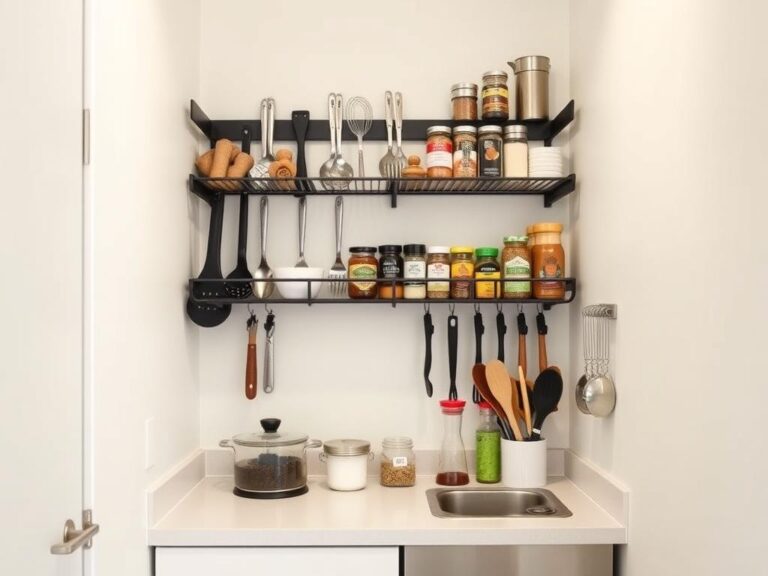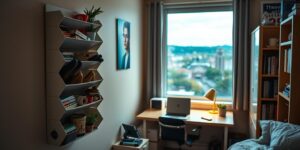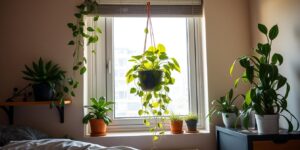How to personalize your study corner for better focus
Boost your productivity by learning how to personalize your study corner for better focus. Our listicle provides actionable tips to create a conducive study environment.
A dedicated workspace can transform how you absorb information and tackle tasks. Research shows that consistent environments train the brain to enter “work mode” faster, improving both retention and efficiency. This principle applies whether you’re reviewing notes or preparing for exams.
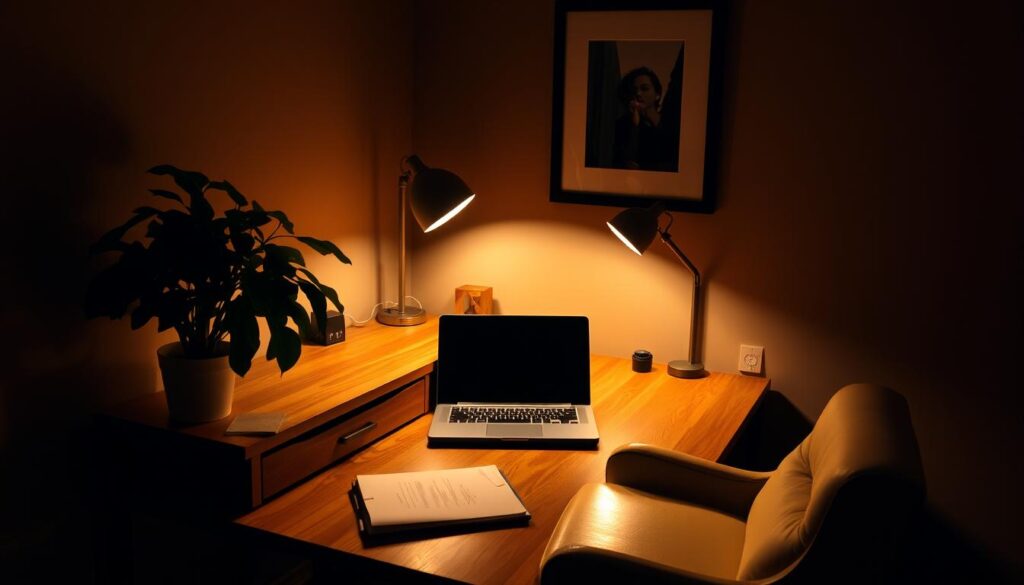
Effective areas don’t require major renovations. Simple adjustments like proper lighting or decluttering often make the biggest difference. Nursing educators emphasize reserving this zone exclusively for learning to strengthen mental associations with productivity.
Many assume expensive furniture or large rooms are necessary, but even compact corners can become high-performance hubs. The key lies in intentional design choices that minimize distractions while maximizing comfort. From chair ergonomics to wall color psychology, every detail plays a role.
This guide explores practical strategies to enhance any existing area. Discover how to optimize natural light, implement smart storage solutions, and select decor that supports concentration. We’ll also debunk common myths about what makes spaces effective.
Key Takeaways
- Dedicated learning zones strengthen mental focus through consistent use
- Simple design changes often create the most significant improvements
- Environmental consistency helps trigger productive mental states
- Lighting and organization systems directly impact task efficiency
- Effective spaces work across various budgets and room sizes
Understanding the Importance of a Personalized Study Environment
Custom environments activate neural pathways associated with routine, priming the brain for intensive tasks. Interior designer Megan Murray notes:
“Spaces that mirror individual preferences create mental shortcuts to productivity – like training wheels for concentration.”
What Else Would You Like to Know?
Choose below:
Her 15 years of commercial design experience reveal patterns in how people interact with workspaces.
Environmental psychology studies highlight three critical benefits:
| Factor | Impact | Optimal Adjustment |
|---|---|---|
| Lighting | Regulates alertness | Combined natural & warm artificial light |
| Color | Affects mood | Blue tones for calm, yellow for creativity |
| Layout | Influences movement | Clear pathways between key areas |
Kinesthetic learners often benefit from standing desks, while visual thinkers thrive with organized wall displays. A Johns Hopkins University experiment found customized spaces improved test scores by 18% compared to standardized setups.
These adjustments reduce cortisol levels by 22% during work sessions, according to recent biometric data. The brain associates tailored environments with purposeful activity, making transitions into focused states more automatic over time.
How to personalize your study corner for better focus
Finding the right spot in your home can turn even the smallest nook into a productivity hub. Start by mapping high-traffic zones versus quiet areas using a simple noise-level chart. Spaces near kitchens often disrupt focus, while bedrooms offer better sound control.
Location analysis makes all the difference. Measure natural light availability at different times using free smartphone light meters. North-facing windows provide steady illumination, while east-facing ones boost morning energy.
| Location | Benefits | Setup Tips |
|---|---|---|
| Basement | Sound insulation | Add warm lamps & acoustic panels |
| Under-stairs | Space efficiency | Install floating desk & vertical storage |
| Bedroom corner | Accessibility | Use room dividers for separation |
“The best learning zones marry convenience with sensory appeal,” says ergonomic designer Laura Chen. “Even transitional spaces become effective when designed intentionally.”
Psychological studies reveal dedicated areas improve task commitment by 34% compared to multi-use surfaces. Define boundaries using rug placements or shelf partitions. This signals “work mode” to your brain automatically.
For shared living situations, try foldable desks that disappear when not in use. A UCLA experiment found students using consistent spots completed assignments 27% faster than those shifting locations daily.
Optimizing Lighting for Better Focus and Productivity
Lighting quality directly impacts cognitive performance and visual comfort during extended tasks. Harvard research shows exposure to natural light increases serotonin levels by 31%, enhancing alertness and information retention. Position desks near windows facing north or east to maximize daylight without glare.
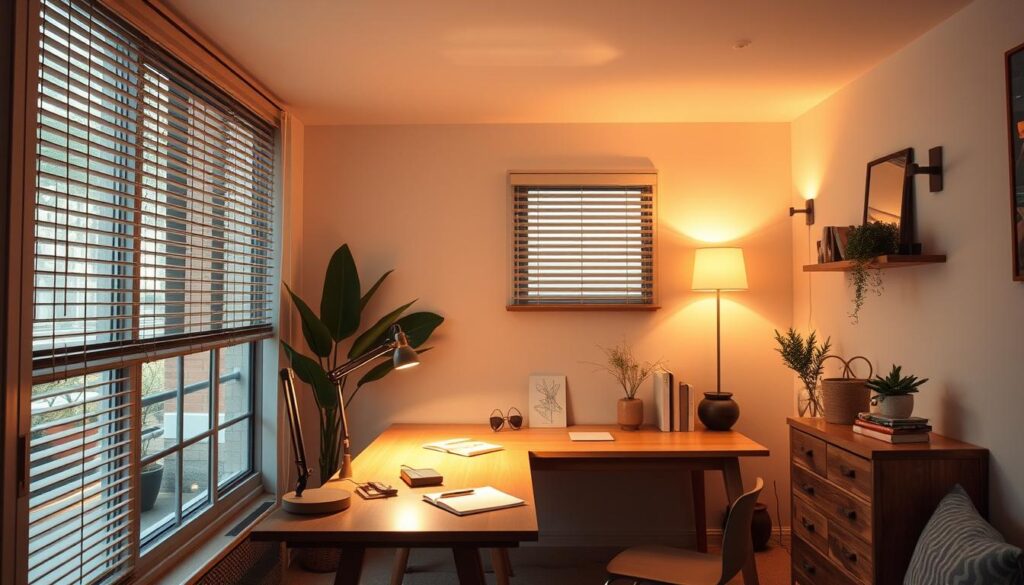
Artificial lighting requires strategic layering for different activities. Use three-tier systems combining:
| Light Type | Purpose | Ideal Placement |
|---|---|---|
| Ambient | General illumination | Ceiling fixtures with dimmers |
| Task | Detailed work | Adjustable desk lamps at 40° angle |
| Accent | Visual relief | Wall sconces or floor lamps |
Position task lights 16-24 inches from work surfaces. Lighting designer Elena Torres advises:
“Match color temperatures to tasks – 5000K for analytical work, 2700K for creative brainstorming.”
Avoid these common errors:
- Overhead lights creating screen glare
- Single light source causing shadows
- Blue-heavy LEDs before evening sessions
Budget-friendly solutions include LED strips under shelves and clip-on book lights. Cornell University found layered lighting reduced eye strain reports by 42% in student groups.
Choosing Ergonomic and Functional Furniture
Ergonomic furniture forms the backbone of any effective learning environment. Adjustable chairs with lumbar support maintain spinal alignment, reducing fatigue during multi-hour sessions. Look for models with breathable mesh backs and seat depth customization to match body proportions.
Desk selection impacts both posture and workflow efficiency. Standard table heights range from 28-30 inches, but adjustable models accommodate various activities. Standing desk converters offer flexibility, letting users switch positions without sacrificing workspace.
| Feature | Benefit | Budget Option |
|---|---|---|
| Chair armrests | Prevents shoulder strain | Removable pads |
| Desk cable ports | Reduces clutter | DIY grommet kits |
| Table edge curve | Improves arm positioning | Foam wrist rests |
Ergonomic designer Laura Chen advises:
“Test chairs by sitting for 15 minutes – discomfort that appears later often gets overlooked during quick trials.”
Affordable solutions exist for tight spaces. Wall-mounted folding tables serve as compact work surfaces, while storage ottomans double as footrests. For existing furniture, seat cushions and monitor risers can enhance comfort at minimal cost.
Prioritize furniture that adapts to multiple tasks. A sturdy table supporting both writing and laptop use prevents constant repositioning. Proper setup ensures forearms stay parallel to the floor, keeping joints neutral during typing or note-taking.
Creating a Distraction-Free Study Zone
Minimizing interruptions requires strategic environmental controls and habit formation. Digital devices rank as the top focus disruptors, with phone notifications reducing concentration spans by 40% according to Stanford research. Establish clear tech boundaries by activating “Do Not Disturb” modes or using app blockers during sessions.
Physical environment adjustments prove equally crucial. Cluttered surfaces increase cognitive load, while ambient noise below 50 decibels enhances information processing. Consider these solutions for common issues:
| Distraction Type | Solution | Effectiveness |
|---|---|---|
| Social media alerts | Website blockers | 47% fewer interruptions |
| Household noise | Noise-canceling headphones | 29% better retention |
| Visual chaos | Modular desk organizers | 32% faster task completion |
Behavioral psychologist Dr. Rachel Kim notes:
“Environmental cues like specific lighting or background sounds create neural triggers that anchor focus. Consistency turns these practices into automatic routines.”
For shared living spaces, implement visual signals indicating study time. A closed door or designated lamp color helps housemates recognize active work periods. Sound management proves vital – foam panels or bookshelves dampen external noise in open-concept areas.
Auditory preferences vary significantly:
- Instrumental music boosts analytical tasks
- White noise enhances creative thinking
- Complete silence benefits memorization drills
Establish transition rituals like brewing tea or stretching to mentally prepare for intensive sessions. These habits signal the brain to shift into deep work mode, even in challenging environments.
Personalizing with Decor: Inspiring Touches and Accents
Strategic decorative choices elevate functional spaces into motivational hubs. Thoughtful arrangements stimulate cognitive engagement while reflecting individual personality. Balance proves essential – clutter-free surfaces maintain focus, while curated accents spark inspiration.
Memory-Driven Motivation
Displaying academic certificates or project milestones creates visual reinforcement of progress. A 2022 UCLA study found visible achievements increased task persistence by 19% across age groups. Position awards at eye level near workstations for frequent subconscious reinforcement.
Nature-Infused Design
Greenery introduces biophilic benefits while softening rigid workspaces. NASA research confirms certain species remove airborne toxins, improving air quality by 25%. Consider these low-effort options:
| Plant | Light Needs | Care Frequency |
|---|---|---|
| Snake Plant | Low | Monthly |
| Pothos | Medium | Weekly |
| ZZ Plant | Any | Biweekly |
Artwork selection follows color psychology principles. Blue tones enhance concentration, while yellow accents stimulate creative thinking. Framed landscape photographs provide mental escapes during intensive sessions.
Interior designer Emma Carter advises:
“Rotate decorative elements seasonally to prevent visual fatigue. Three focal points per workspace maintain interest without distraction.”
Textured elements like woven baskets or ceramic pencil holders add tactile variety. These subtle touches create sensory richness while serving practical functions. Lighting accentuates decor – directional spots highlight achievement displays, while diffused glow showcases greenery.
Effective Storage and Organization Solutions
Clutter-free surfaces prove essential for maintaining cognitive clarity during intensive tasks. Strategic storage solutions transform chaotic areas into streamlined workspaces, reducing time spent searching for materials by 41% according to Princeton neuroscience research. Proper organization systems create visual calm while keeping essential items within arm’s reach.
Desk Organizers and Cable Management Ideas
Multi-tier organizers maximize limited desk space while separating frequently used items. Consider these options for different needs:
| Organizer Type | Best For | Capacity |
|---|---|---|
| Rotating trays | Small supplies | 12-15 items |
| Monitor risers | Tech accessories | 3-5 devices |
| Magnetic strips | Metal tools | 8-10 pieces |
Cable management prevents tripping hazards and visual stress. Use adhesive clips under desks to route charging cords, and label each wire with colored tags. Office supply stores sell spiral wraps that bundle multiple cords while allowing easy access.
Vertical Shelving and Hidden Storage Tips
Wall-mounted systems free up floor space for movement and larger furniture. Floating shelves above desks hold reference books without consuming work surfaces. Consider these space-saving approaches:
| Solution | Space Used | Storage Capacity |
|---|---|---|
| Corner units | Unused angles | 20-25 books |
| Pegboards | Vertical walls | 15-30 items |
| Storage ottomans | Floor areas | 6-8 textbooks |
Hide seasonal materials in decorative boxes under beds or behind room dividers. Retail analyst Mark Thompson notes:
“Students using hidden storage systems report 23% faster cleanup times compared to open shelving users.”
Rotate stored items monthly to maintain relevance and prevent overflow.
Maximizing Small Spaces for Optimal Study Areas
Limited square footage challenges traditional workspace setups but sparks creative solutions. Urban dwellers and students increasingly adopt space-conscious designs that maintain functionality without compromising comfort. The right approach turns constraints into opportunities for innovative organization.
Creative Desk Alternatives for Compact Rooms
Wall-mounted units revolutionize cramped environments. Fold-down models disappear when unused, while corner installations exploit often-wasted angles. A 24-inch deep surface accommodates laptops and notebooks comfortably.
Portable bed desks offer flexibility for temporary setups. Many feature adjustable legs and built-in storage compartments. Though not ideal for long sessions, they provide essential support during space crunches.
Multi-Functional Furniture Options
Convertible pieces serve dual purposes in tight quarters. Storage ottomans with flip-top desks combine seating with work surfaces. Bookshelves with pull-out tables maximize vertical space efficiently.
Vertical organization systems prove vital in small rooms. Pegboards hold supplies while magnetic strips keep metal tools accessible. Overhead racks store rarely-used items without consuming floor space.
FAQ
How does natural light improve focus in a study space?
What furniture is best for small study areas?
How can I reduce distractions in a home office?
Are plants beneficial for a study environment?
What storage solutions work for tight spaces?
How do ergonomic chairs enhance productivity?
Can decor choices impact concentration?
What’s the ideal desk setup for dual monitors?
Tiny Kitchen, Big Ideas: Organizing Your Small Student Kitchen
» See exclusive tips for your home


